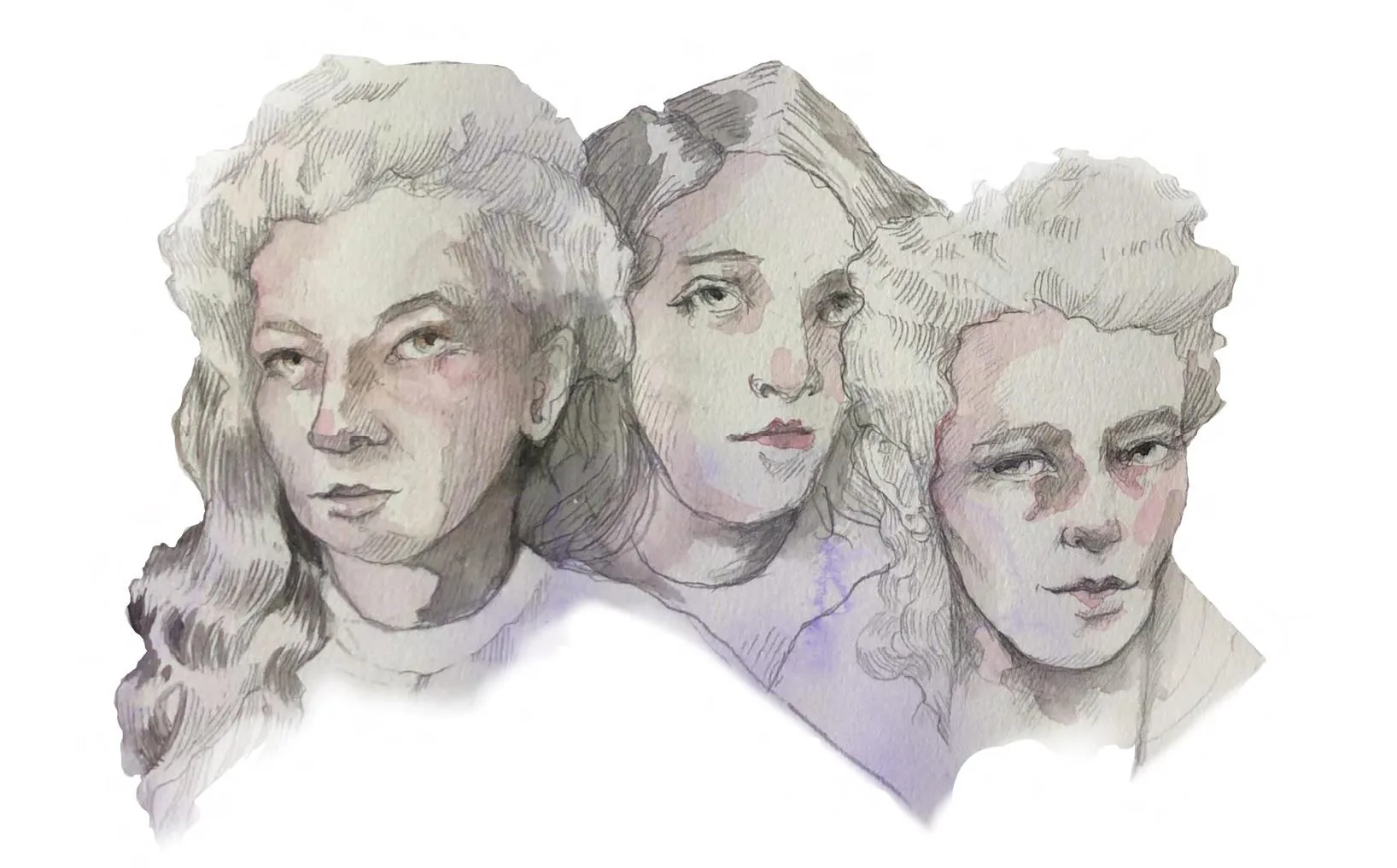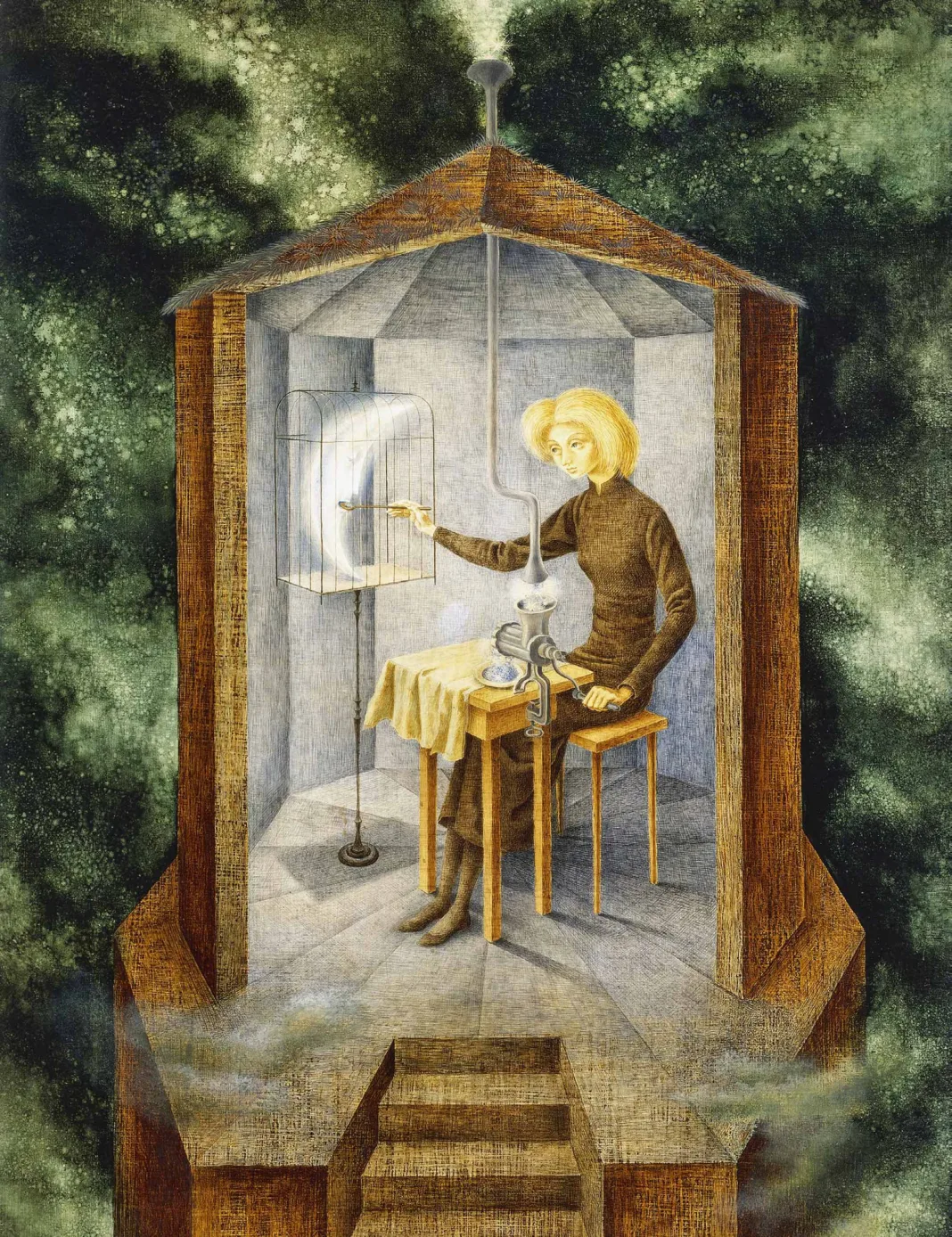Feature Image:
Celestial Pablum (1958), by Remedios Varo

If you plan to travel to Mexico City, you will likely be cautioned, both by the internet and well-intentioned people, about the many perils of that metropolis. They may tell you not to stray from “tourist approved” neighborhoods or not to travel alone at night. People will warn you of poor water quality and pickpockets. You’ll hear stories
of kidnappings.
These, in any case, were the things I was cautioned against. Being bitten by an ugly squirrel during an earthquake drill was not on that list. Yet here I was, nary a kidnapper in sight, pockets unpicked, watching blood well up from a puncture wound in my left hand. I was standing on sunny Avenida de la Reforma, having just been evacuated from the Museum of Modern Art. Perched on a nearby tree branch was the offender—a scrawny, dung-brown creature who chittered triumphantly. While I tried to remember if my rabies vaccine was up to date, he taunted me with flicks of a tail that looked as though it had been pulled from a shower drain. Meanwhile people surged around me, thousands of them, moving in quiet, orderly waves while helicopters rumbled overhead. Traffic on the streets had been stopped, and emergency vehicles, enacting disaster-preparedness drills, sped through the unobstructed intersections with lights and sirens running. It was a spectacle to behold, balletic and bizarre.
It was suitably surreal, given the circumstances that brought me to Mexico City. I had come because I had become bewitched with the work of Leonora Carrington, a Surrealist artist and writer, after reading her novel The Hearing Trumpet. A friend gave me this strange little tome, filled with naive and mysterious drawings, as I was leaving the Pacific Northwest for Europe. I had a wedding to attend in England, and family to visit in Austria. But mostly I needed to reconnect, to be with my oldest and most trusted friends there whom I hoped would be able to help me find my way forward. I’d had a difficult year that had left me feeling untethered. My relationship of fourteen years had come to an end, and my ex-partner had moved on. My son finished university and was now a full-fledged adult with his own life to live. Then I fell completely and imprudently in love, a brief, dramatic relationship that ended in heartbreak.
Suddenly, I simply couldn’t recognize the person I had become: someone who cried a lot and was pining like a middle schooler. What happened to that independent, productive, strong person whose identity was not completely based on romantic relationships or motherhood? For years I had traveled on my own, had my own friends and interests, and I’d never minded doing things alone. But I’d always had a home to come back to—not a place so much as the people who were waiting for me. Where is home if no one is waiting for you? For the first time in my life, I couldn’t imagine my own future. I wasn’t sure who I was or where I wanted to be. Without the anchor of motherhood or a stable relationship, I was adrift.
In Vienna, I saw my brother and his family and spent time with old friends. During a midnight ramble along the Donaukanal, a dear friend turned to me and said, “You need a project. Go somewhere you haven’t been, sketch, write, do research. It’s what has always pulled you out of a slump.” As I traveled to England for the wedding, her advice continued to percolate. I remembered a project I’d always wanted to pursue, writing about the witches from the Odyssey—Circe and Calypso, of course, but also Helen, Penelope, Scylla, the Sirens. I decided then that I would go from England to Greece.
But as much as I thought I should be studying maps of Athens and reading Homer to prepare, I found myself turning more often to the pages of The Hearing Trumpet. The protagonist of the story is a delightful though possibly senile ninety-two year old woman unwillingly relegated to a bizarre old-folks home. It was refreshing to read a story in which an older woman is more than just a main character’s grandmother or elderly neighbor or rich aunt. The book, and Leonora Carrington herself, began to take over my life. Small connections and coincidences drew me away from Homer and ever closer to her work and the story of her life. At the Tate Museum in London, I searched for a particular artwork referencing the monster Scylla but found a piece by Carrington instead, exactly where I was told Scylla was supposed to be. Later that night, I met a friend for drinks at a bar that turned out to boast a collection of original Carrington works.
That evening, I sat down at my laptop and began to research her life further. In 1942, at age twenty-five, Leonora Carrington left Europe for Mexico City. She settled in a neighborhood called Colonia Roma, where she spent the rest of her life, nearly six decades. There she formed deep collaborative friendships with two other artists, Kati Horna and Remedios Varo, who, it turned out, was the basis for a character in The Hearing Trumpet, the protagonist’s best friend. Carrington drew from Varo’s paintings and illustration for many of the settings and buildings of the novel’s old-folks home as well.
They were not the only artists to settle in Mexico City. The city has a gravity that attracts. The sheer size of the population, more than 10 million, attests to that. Some undoubtedly come for school or work or for the climate and the culture, but the city also has an undercurrent of magic, vibrancy, and strangeness. During World War II, Mexico City experienced an influx of artists (including Surrealist André Breton) who found that the city was not only was conducive to their work but that a lively local group, including Frida Kahlo and Diego Rivera, were already there working with the uncanny, the subconscious, and the mystifying. The poet Luis Cardoza y Aragón vividly captured the allure of the place in a letter to Breton: “We are in the land of convulsive beauty, the land of edible delusions, a place for the mutable, the disturbing, the other death, in short, a land of dream, unavoidable by the surrealist spirit.”
But what brought Carrington specifically to Colonia Roma, where her life was to become entwined with such kindred spirits as Horna and Varo? It made me wonder if there was some special gravity to that particular place. Why else would these people that leaned so heavily toward magic, the subconscious, alchemy, and witchcraft all end up in the same neighborhood? The three women artists became known locally as las tres brujas: the three witches. It was approaching midnight as I sat wondering if I should change direction. Were these the witches I should be writing about?
I looked at the photo on my screen—a picture of Carrington taken by Horna. Carrington’s eyes are dark and hooded, her face angular, cheekbones high; she’s serene and serious and very beautiful. Under the photo the caption read, “Born 6 April, 1917.” I looked at the calendar. It was April 6. “Oh come on!” I exclaimed out loud. Just then, my email pinged with a promotional offer for flights to Mexico City. It seemed inevitable, inescapable. I made new travel arrangements.
When I arrived in Mexico City in early April, it felt like a perfect summer afternoon. In the Plaza Río de Janeiro, one of the squares in Colonia Roma, I reveled in the sunny equatorial warmth and tried to imagine Leonora Carrington, Remedios Varo, and Kati Horna upon their arrival during World War II, and what they might have felt. All three women had lived within blocks of this plaza, where a full-scale replica of Michelangelo’s David graces the central fountain.
I’d been to this spot several times since arriving, though not deliberately. Usually when I set out to do one of my projects, I make fairly detailed plans, create a budget, a timeline, and an agenda of places to visit, make appointments with local scholars, draft a list of where to find the best fatty snacks. But this journey was unplanned, and I didn’t quite know what I was looking for. Why had these artists chosen this of all places to spend the rest of their lives? Why had they decided that this place, where they were conspicuously branded as witches, was home? Could I find my place the way that they had?
I decided to explore the neighborhood organically, using “psychogeography,” an experimental method I had read about in grad school and had always wanted to try. It was developed by the French theorist Guy Debord and was based on his concept of the dérive—French for “drift.” Debord defined this as “a mode of rapid passage through varied ambiences, usually urban, in which participants drop their everyday relations, and let themselves be drawn by the attractions of the terrain, and the encounters they find there.” One just walks through the city without an agenda, allowing themselves to be pulled to places that attract and avoiding those that repulse.
This seemed like the sort of process that would have pleased Carrington, Varo, and Horna, who were famous for their playful, off-kilter social experiments … like, for example, having dinner parties for which they’d pick random guests out of the phonebook. But it also seemed to suit where I was at too. I felt like I was drifting through the map of my own life, allowing coincidences, characters from books, and random encounters to dictate my direction. Having abandoned myself to the drift and entering Carrington’s world, the coincidences had continued to mount and become more uncanny. In The Hearing Trumpet, one of the primary characters has a malformed eye. Two other characters, both nuns, suffer eye injuries. En route to Mexico, I sustained a vascular injury to my left eye, which didn’t particularly affect my vision but did look quite dramatic. With each passing day I felt more resolutely tied to the book that had brought me there….






























 Enchanted Living is a quarterly print magazine that celebrates all things enchanted.
Enchanted Living is a quarterly print magazine that celebrates all things enchanted. 



